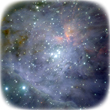
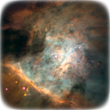
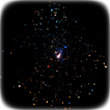

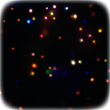
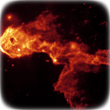
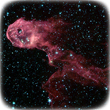
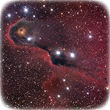
























This movie was made from images taken at radio wavelength of the forming massive star, or protostar, known as Source I. The radio wavelength data were obtained using the VLBA.
The protostar itself is invisible in the image because it is too dim to be detected by the VLBA. By contrast, clouds of gas that emit light very strongly in the microwave/radio portion of the electromagnetic spectrum can be detected. The reason that these clouds of gas emit such intense beams of radio light is because they are naturally-forming microwave/radio lasers, i.e., the radio analog of the lasers used in supermarket scanners, DVD players, and lecture hall pointing devices. Known as MASER emission, the extremely bright, concentrated source of radio light from separate gas clouds can be detected by the VLBA. This allows astronomers to track the motions of the clouds as they move in space.
Using the VLBA, the KaLYPSO group at the Harvard-Smithsonian Center for Astrophysics observed the MASERs in Source I once per month for nearly two years. By taking separate snapshot images of Source I and superimposing them, they were able to create a movie of the MASER emission originating from the moving gas. This enabled study of how Source I is forming into a star.
The colored spots in this movie mark the different gas clouds that track motion of gas flow in Source I. Each spot represents a gas cloud about as big as a tenth of the distance between the Earth and the Sun, a very small size when it comes to dealing with astronomical objects. The colors indicate whether the MASER sources are moving toward us (blue) or away from us (red), whereas the orange and green colors show emission from gas that is not moving so rapidly.